#admin: whitewings
Note
hey i really would like to join your writer server but as of rn ive never written hetalia fanfiction. Can i still join if im an aspiring/beginnger writer with no prior public works?
We are happy to accept applications from aspiring writers who have yet to share their fics publicly. However, we are specifically a Discord group for Hetalia fanfic writers; we are not a general fic writing group. Outside of writing, the day-to-day chats will revolve around Hetalia or Hetalia-related topics.
All this to say is, if you're a writer AND a fan of Hetalia you are welcome to join (but being both is a requirement).
4 notes
·
View notes
Text

Hello! I'm WhiteWings, and I mostly write smutfics for Hetalia. I've written for a wide range of pairings, but my main ships are RoChu, RusPru, and RusAme — if it isn't obvious, my blorbo is APH Russia.
filters · all fics · favourites · popular · requests
rating · general · teen and up · mature · explicit
elsewhere · archive of our own · fanfiction.net · livejournal
Co-admin with @cluster-bi at the Hetalia Writers' Association.
1 note
·
View note
Text
Valentia and Magvel World Map Similarities
In lieu of our monthly Unit of the Month post, we’ve decided to do a special feature on Gaiden/Echoes: Shadows of Valentia. Admin Ree did a small writeup before on the mechanical similarities that FE8 drew from FE2, and now Admin Zebra here has decided to point out the (many) similarities between Valentia and Magvel’s world maps.
(Warning: There will be references to spoilers and a couple of pictures.)
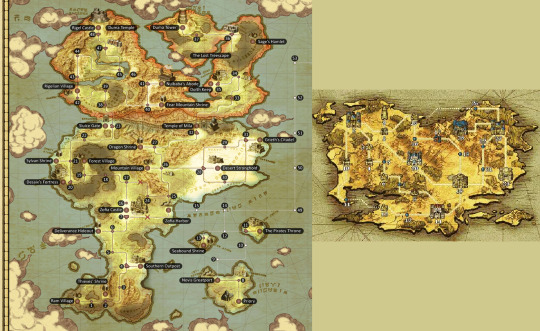
I’m not advocating that the two continents are particularly related in any way, but there are a good number of similarities that FE8 takes from even the world map of the older game.

Starting with the northernmost parts of the two maps, Rigel Castle is in a very similar position to Frelia Castle (#2 on Magvel’s map). (While Frelia’s climate is never specified, at least in some other FE games, pegasi come from snowy, cold areas and Rigel is known for its snow and ice even if we don’t see any Pegasus Riders hail from that region in FE2.)
To the right of either castle is a tower in their countries’ territories. Although Duma Tower would be more where Melkaen Coast is on Magvel’s map (26 in the image), they both play an important role to the two countries; Duma Tower holds, unsurprisingly, Duma himself, while the Tower of Valni held Frelia’s Sacred Stone. They also make for some really good grinding opportunities.

To the far northeast of both world maps are the final areas of the game: On Celica’s side, she goes into the heavily-forested Lost Treescape, within which Sage’s Hamlet was established. In Magvel, the combined party travels to Rausten, which by the map is also a heavily-forested country. Both Sage’s Hamlet and Rausten Court are the residences of a religious leader as well (Halcyon/Hark is the deposed ruler of the Duma Faithful, while Mansel is the rightful leader but banished the heretic Riev, who in turn went to Grado and at least helped the return of the Demon King).
En route to that region, both Celica’s party and the FE8 party pass through areas with HP-penalty tiles. (Though in FE8, Thieves, Rogues, and Assassins are able to disable the lava tiles. Somehow. They have some real dexterous fingers.)
Furthermore, the final battles both occur to the region to the west of the final “safe zones” for Celica’s party and the FE8 party (Sage’s Hamlet and Rausten Court). Said regions are also the holding areas of the final boss, who are revived in time for the final battle.
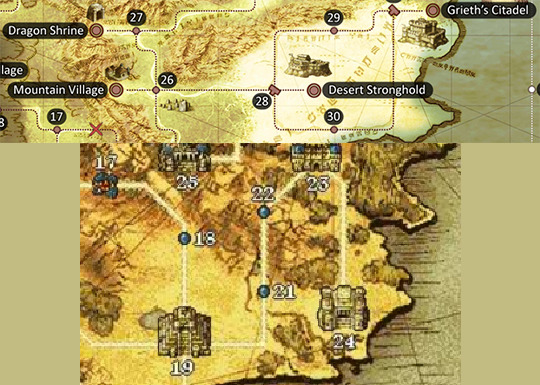
To the south of those two regions are deserts, also at the far eastern end of the two continents. Jehanna, like Grieth’s former territory after the war, is a country of mercenaries. To the east of both deserts (or northeast, for FE8) is a village, where a person who lives there joins your group to pass through the desert for their own purposes. In Gaiden/SoV, it’s Atlas, a villager who wants to defeat Grieth and bring his brothers back home. In FE8, it’s Saleh, a Sage who is in search of Myrrh and joins Eirika’s party so that they can reunite with Ephraim’s party, which Myrrh chose to travel alongside with.
(Caer Pelyn seems to be a composite of both the Mountain Village and the Forest Village on Alm’s route where Luthier and Delthea hail; geographically, it’s more like the Mountain Village, while the residents of Caer Pelyn seem more inclined to magic and have a legendary heroine in their history much like how Luthier and Delthea are descendants of a great female mage. Granted, the “descended from a great female mage” stuff seems to be new to SoV and wasn’t mentioned in Gaiden, so that specific example is shakier.)
While passing through Jehanna is mandatory, unlike the desert in Celica’s route, both of them technically have an optional location; at the ends of the deserts are Grieth’s Citadel and Lagdou Ruins. Celica can choose to ignore Grieth (and the whole desert) entirely at the expense of Atlas, the Whitewings, Jesse, and either Deen or Sonya. While Lagdou Ruins seems to be more of an offshoot of Rausten rather than Jehanna, it’s located in the desert area, east of Jehanna Hall (which could stand in for Valentia’s Desert Stronghold), and is entirely optional for the main campaign.
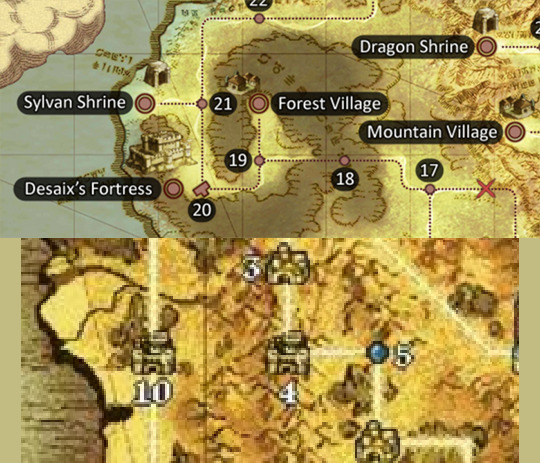
In the western middle section of both continents is a fortress that Alm and Ephraim’s parties assault before heading into the main body of the enemy country. They’re also both held by large-bodied men with equally large egos, Desaix and Gheb, who take an important noblewoman (Mathilda and Tana) as prisoners. (Said women also tend to turn out as war goddesses; although Mathilda lost her ponytail in her redesign, Gaiden Mathilda and Tana both have long flowing ponytails. Tana could also be seen as a composite character of Clair and Mathilda; having Clair’s class, a crush on the male Lord, and an older brother who is renowned throughout their continent, and a design similar to Mathilda. She also gets captured twice, while Clair and Mathilda were each captured once.)
To the east of the fortress is a village in the forest. Though I said that Caer Pelyn seems to be a composite of the Mountain Village and the Forest Village, Za’ha Woods (#5) is very definitely akin to the Forest Village, as you get two magic users (Lute and Artur) there, matching Luthier and Delthea. (It probably also isn’t coincidental that Artur and Lute’s growth specialties are similar to Luthier and Delthea’s; Artur and Luthier having more HP and Skill while Lute and Delthea have more Magic and Speed.)
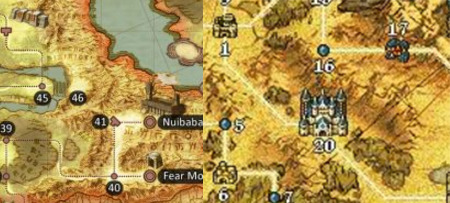
Closer to the center of either continent is a rather prominent mountain range. Between The Last Bastion of Valentia’s map (the area below Rigel Castle/Duma Temple) and the Fear Mountain Shrine is a mountain range that bears a small similarity to the mountain range between Frelia’s Border Mulan to the tip of Jehanna. Nuibaba’s Abode sits within that mountain range much like how Castle Renais sits at least close to it, though luckily we don’t need to deal with Medusa when we wrestle Castle Renais back from Orson.
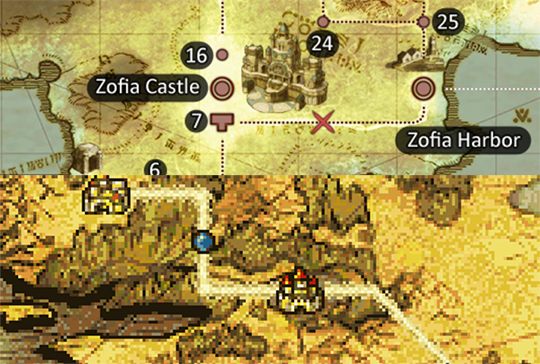
The first third of both stories (Acts 1+2 in Gaiden, Chapters 1-8 in FE8) end at a fortress that is pretty close to the ocean/a large body of water. Both are notably surrounded by a moat and boast an impressive defense that is broken through by your party. Plot-wise, it’s also where both Lords of their respective games meet up before they split up; Celica pays a visit after hearing of Alm’s victory over Desaix, while Eirika went under the impression of freeing Ephraim and Ephraim doubles back to keep her from falling into the trap.
Also good to point out is that this location gets to show off prominent mid-game villains. Desaix and Valter appear in Zofia Castle and Fort Renvall, respectively, but neither are fought there; both hatch plans to defeat/capture your party there, but while Desaix underestimates them and flees/leaves a body double to take the fall, Valter is implied to have purposely let Ephraim’s party go (and probably assumed that Tirado would fall to them too). Both will fall in the second third of the story, Desaix in Act 3 and Valter in Chapter 15.
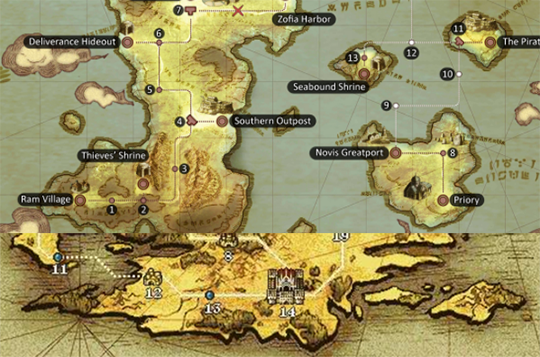
And last but not least, the southernmost part of the two continents. While the western sides bear almost no similarities, both have islands off the eastern coast. While the islands have no significance to FE8, what is also notable is that the game’s only boat chapter occurs in the western side, while Celica has several boat maps between Novis Greatport and Zofia Harbor.
(Also intriguing is that in Ephraim’s boat chapter, while Riev doesn’t stick around as a boss, he does summon monsters that Ephraim’s party must fight, much like how Celica’s party first encounters a Cantor on a boat who summons Terrors to fight them. Cantor Riev when?)
In conclusion: Magvel is actually just Valentia condensed, just as FE8 is the spiritual successor of FE2, if not just FE2 lite.
#Fire Emblem: Gaiden#Fire Emblem Echoes: Shadows of Valentia#Fire Emblem: The Sacred Stones#fe15#fe8#fe2#valentia#magvel#meta#admin: Zebra
73 notes
·
View notes
Text
SoV Countdown : History of Valentian Religion & Transition to Nagaism
As promised, we’re kicking off the month of May with periodical meta posts written and curated by the admins. Expect at least two a week until June, and if you wish to further discuss these topics with us, then we encourage you to check out our discord server (password: shouzoukaga)! Now, without further ado...
At this point, most fans know that Valm (in Awakening) is Valentia 2000 years in the future; however, one of the things that has been criticized about Awakening’s Valmese arc is that Dumaism is not mentioned at all. The Valmese, instead, worship Divine Dragons and make only brief mention of Mila. This lack of Milaism/Dumaism is interesting since the culture in Valentia was very much wrapped up in its two opposing belief systems, and specifically, Walhart and the Valmese Empire closely resemble the Rigelian Empire, which followed Duma’s philosophy of power. So where’s Duma then? In this post, I seek to shed some light on why Dumaism might have been lost to Valmese history, beyond the excuse that developers simply forgot.
Most of the following is canon information in Gaiden, not SoV, and elaborated by theory. Some Gaiden spoilers are included, but I have placed warnings around the major ones.
First of all, a brief history of Valentia’s two cultures for those who are unfamiliar with Gaiden: Zofia and Rigel have been two completely separate countries, led by two very different philosophies (Love vs Power, Leisure vs Discipline, Emotional vs Physical, etc., respectively) for nearly 300 years by the time Gaiden takes place. While there may have been some overlap and sharing between the two countries in the beginning, they probably grew more and more disparate as the years passed and they built up their own cultures. Mila and Duma are said to have been warring deities as well, so as long as this belief remained pervasive throughout Valentia, the rift between Zofia and Rigel only grew more intense with time.
Eventually, the people of Zofia became lazy and corrupted by Mila’s bounty, and the people of Rigel grew cold and heartless in pursuit of power. While there may have been slights on both sides, the events of Gaiden are set in motion when Emperor Rudolf of Rigel requests aid from Zofia and Zofia refuses to share despite the fact that its country is bountiful in resources and food. It occurs to him then that Valentians have become too reliant on their gods, too short-sighted by their philosophies, and as long as they continue to refuse aid from or refuse to aid their neighbors, then Valentia as a whole is bound to self-destruct.
Most of Zofia appears to be fairly homogenous in its worship of Mila. There are monasteries and temples all throughout the land, and those who work/live in them are respected and looked to for guidance. On the other hand, Rigel is split into two factions : the capital area and the eastern swamps. Rigelians who live in the capital appear to be less religious, even though they still follow Duma’s philosophy of power, and the only Rigelian magic users we see - aside from the shamans - are Tatiana and Hark. Unfortunately, there is not much in their dialogue that gives us a picture of what they think of Dumaism or their religious practice, but they are clearly different from the antagonistic shamans, who sing Duma’s praise even as they die.
These shamans live on Fear Mountain or in the eastern swamps, separate from the rest of Rigel, and are twisted in appearance. They appear to be far more fanatical in their worship of Duma, even going so far as to trade their souls or offer live sacrifices for spells and power. There’s obvious tension between these two groups, with the shamans even attacking other Rigelians (e.g. kidnapping Tatiana), and while these shamans work under the flag of Rigel, they are religious extremists in comparison to the rest of the country. This doesn’t seem to have always been the case, however, as Hark, the former High Priest of Dumaism, displays far less fanaticism than Jedah, who usurped the position.
Despite these differences, Nomah’s epilogue states that he attempts to unify Milaism and Dumaism after the war. While a nice idea in theory, these attempts likely do not go very far. As mentioned, most Rigelians do not appear that strongly religious, and those opposed to the war from the beginning would probably be apologetic or even ashamed of Dumaism. Of course, there would also be those who blatantly oppose uniting the two religions (as there are probably plenty of people who oppose the unification of Valentia), but in the end, Milaism would prove to be the stronger practice. The continent was united, yes, but Zofia still invaded and beat Rigel, and usually the culture of the losing side fades away with time.
Duma is also recorded in history as an “evil god” - and Rudolf an evil man - but it should be noted that Gaiden’s entire storyline sets up the premise of a clear-cut “good” and “evil,” but then dismantles it at every turn.
-MAJOR SPOILERS-
The drive for Valentia’s betterment had been a joint effort between Duma and Rudolf from the beginning, as it is Duma who gives Rudolf the Falchion to seal away Mila, which then gives rise to the “heroes” Valentia needs. At the war’s end, Rudolf directs Alm to the location of the Falchion and with his dying breath, tells him to seal Duma inside as well. In turn, Duma’s dying words are not of anger, hate, or resentment. He knows his fate, accepts it, and even blesses Alm for his future endeavor to unify Valentia:
That should be enough…
Hero Alm. I entrust everything to you.
Inherit the will of us siblings and govern this land…
Carrying both the strength of Doma as well as the love of Mila, guide the people justly…
You must not repeat the same mistakes we committed.
You must never again disturb our slumber…
However, The battle that went on beneath Rigel Castle probably never made it to the public, so Alm’s supporters continued to believe that Duma was evil and that Rudolf had gone crazy. This became history, and Alm’s reputation became “the Hero Who Slayed the Evil God.” After only a few hundred years, anyone who followed Dumaism would have likely disappeared or been cast out to find asylum elsewhere.
-END SPOILERS-
Over time, Valentia and Archanea shared culture, as the Whitewings, upon their return home, probably enticed visitors to check out the newly unified country. It would not be surprising, then, if eventually Nagaism took root in former Zofia, and with Mila sealed away (and theoretically no longer able to meddle in human affairs), a more tangible god (eventually Tiki) would have been favorably received. After 2000 years, Nagaism would replace Milaism almost entirely, but since Milaism has been recorded in history as a “good” belief system, vestiges of it still remain in Valm.
On the other hand, the only remnants of Duma’s existence are the Demon’s Gate (Inigo’s Paralogue map) and the Demon’s Ingle, which is said to be where Duma’s remains rest. This location is incorrect, however, as Duma’s remains should be just past the Demon’s Gate instead, so this is likely perpetuated as a myth to explain the activity of the volcano in Valm. Walhart’s power-driven way of ruling his nation is also likely a remnant of the Rigelian mentality that managed to survive over the years, but given that Walhart makes no mention of Dumaism, it would be safe to assume that the Rigelian power philosophy separated itself from religious practice. A country doesn’t exactly like remembering it’s evils, after all, and so Dumaism took the blame for the evils of the unification war and became lost to history.
#fire emblem awakening#fire emblem: gaiden#valentia#valm#fe13#fe2#fire emblem: awakening#meta#admin: ree
46 notes
·
View notes